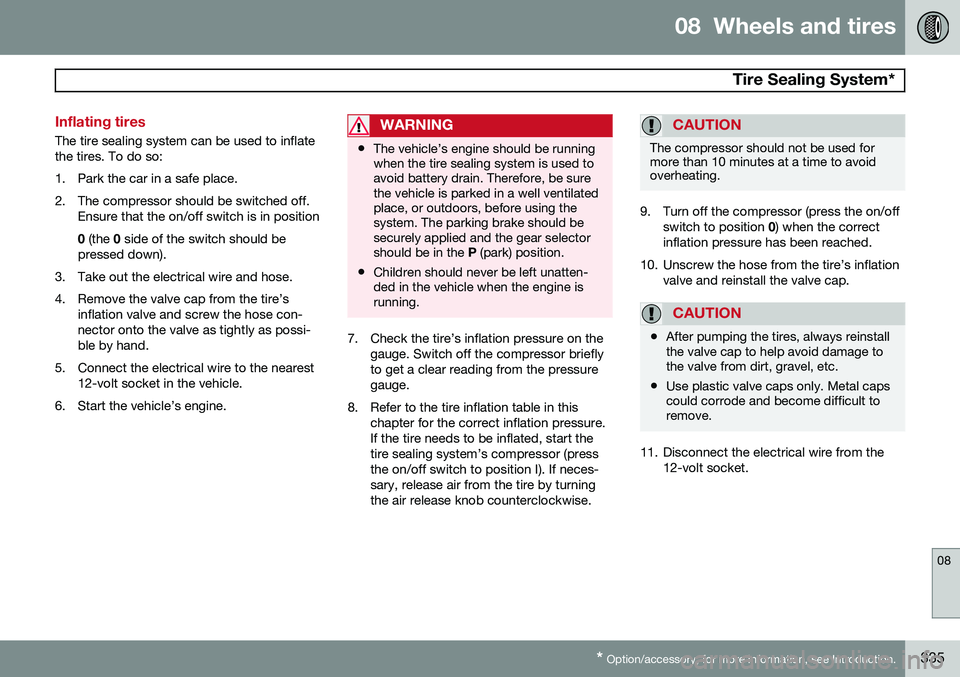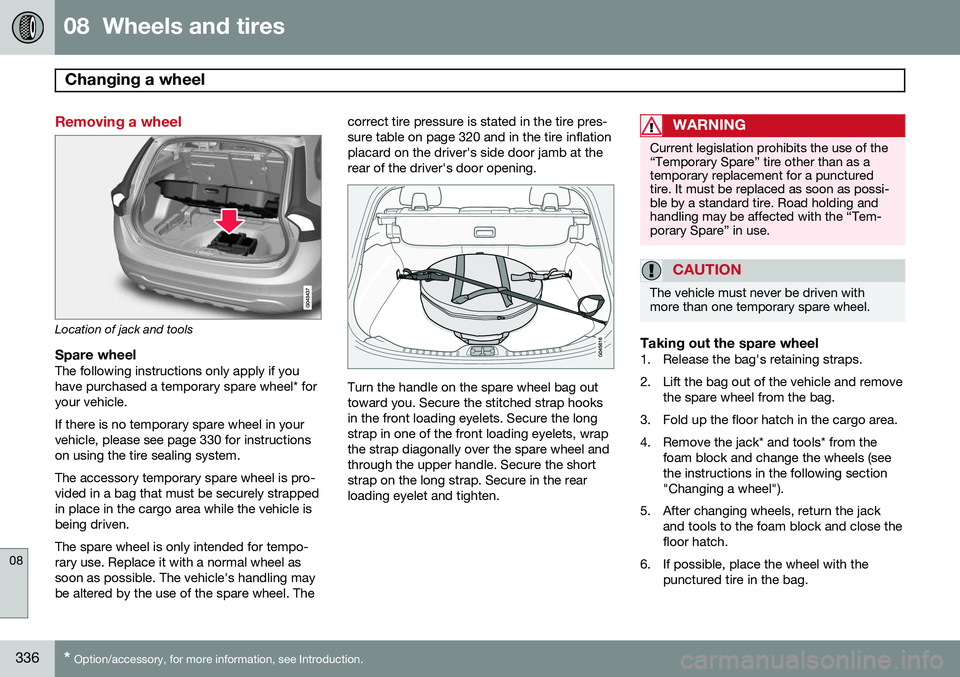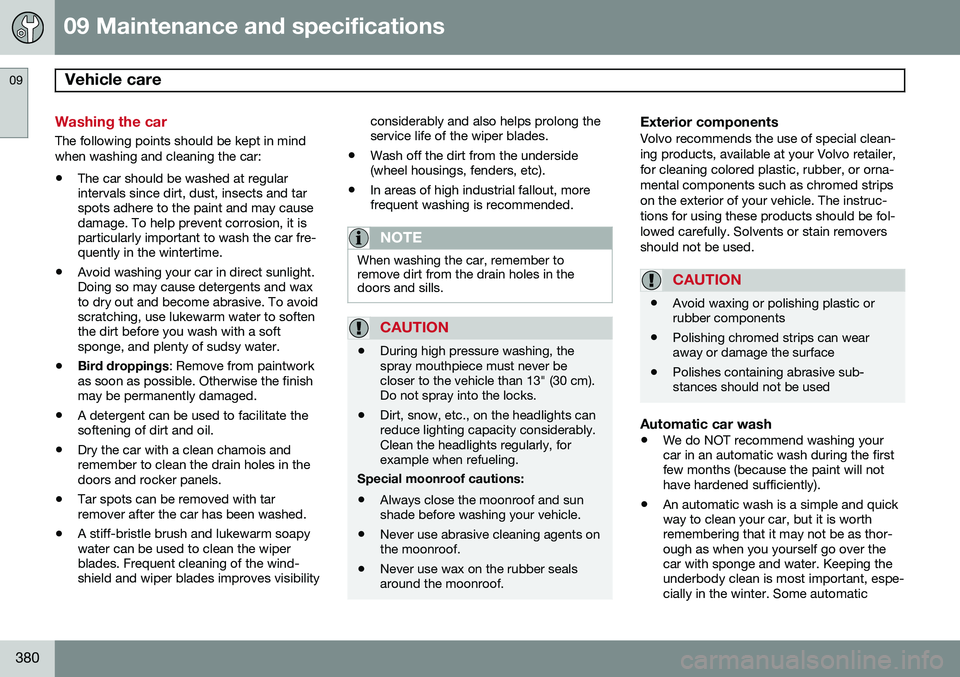2015 VOLVO V60 door lock
[x] Cancel search: door lockPage 301 of 414

07 During your trip
Refueling
07
}}
299
Manually opening the fuel filler door
If necessary, the fuel filler door can be opened manually:
1. Open the side hatch in the cargo area (onthe same side as the fuel filler door).
2. Open a perforated section of the insula- tion and grasp the handle on the green cord.
3. Gently pull the cord straight rearward until the fuel filler door clicks open.
Opening/closing the fuel cap
Fuel vapor expands in hot weather. Open the filler cap slowly. After refueling, close the fuel filler cap by turning it clockwise until it clicks into place.
CAUTION
•Do not refuel with the engine running 3
.
Turn the ignition off or to position I. If
the ignition is on, an incorrect reading could occur in the fuel gauge.
• Avoid overfilling the fuel tank. Do notpress the handle on the filler nozzlemore than one extra time. Too muchfuel in the tank in hot weather condi-tions can cause the fuel to overflow.Overfilling could also cause damage tothe emission control systems.
Emission controls
Three-way catalytic converter
•
Keep your engine properly tuned. Certain engine malfunctions, particularly involvingthe electrical, fuel or distributor ignitionsystems, may cause unusually high three-way catalytic converter temperatures. Donot continue to operate your vehicle ifyou detect engine misfire, noticeable lossof power or other unusual operating con-ditions, such as engine overheating orbackfiring. A properly tuned engine will
3
If the fuel filler cap is not closed tightly or if the engine is running when the vehicle is refueled, the Check Engine Light (malfunction indicator lamp) may indicate a fault. However, your vehicle's performance will not be affected. Use only Volvo original or approved fuel filler caps.
Page 337 of 414

08 Wheels and tires
Tire Sealing System*
08
* Option/accessory, for more information, see Introduction.335
Inflating tires
The tire sealing system can be used to inflate the tires. To do so:
1. Park the car in a safe place.
2. The compressor should be switched off.
Ensure that the on/off switch is in position0 (the 0 side of the switch should be
pressed down).
3. Take out the electrical wire and hose.
4. Remove the valve cap from the tire’s inflation valve and screw the hose con- nector onto the valve as tightly as possi-ble by hand.
5. Connect the electrical wire to the nearest 12-volt socket in the vehicle.
6. Start the vehicle’s engine.WARNING
• The vehicle’s engine should be running when the tire sealing system is used toavoid battery drain. Therefore, be surethe vehicle is parked in a well ventilatedplace, or outdoors, before using thesystem. The parking brake should besecurely applied and the gear selectorshould be in the
P (park) position.
• Children should never be left unatten-ded in the vehicle when the engine isrunning.
7. Check the tire’s inflation pressure on the
gauge. Switch off the compressor briefly to get a clear reading from the pressuregauge.
8. Refer to the tire inflation table in this chapter for the correct inflation pressure.If the tire needs to be inflated, start thetire sealing system’s compressor (pressthe on/off switch to position I). If neces-sary, release air from the tire by turningthe air release knob counterclockwise.
CAUTION
The compressor should not be used for more than 10 minutes at a time to avoidoverheating.
9. Turn off the compressor (press the on/off switch to position 0) when the correct
inflation pressure has been reached.
10. Unscrew the hose from the tire’s inflation valve and reinstall the valve cap.
CAUTION
•After pumping the tires, always reinstall the valve cap to help avoid damage tothe valve from dirt, gravel, etc.
• Use plastic valve caps only. Metal capscould corrode and become difficult toremove.
11. Disconnect the electrical wire from the
12-volt socket.
Page 338 of 414

08 Wheels and tires
Changing a wheel
08
336* Option/accessory, for more information, see Introduction.
Removing a wheel
Location of jack and tools
Spare wheelThe following instructions only apply if you have purchased a temporary spare wheel* foryour vehicle. If there is no temporary spare wheel in your vehicle, please see page 330 for instructionson using the tire sealing system. The accessory temporary spare wheel is pro- vided in a bag that must be securely strappedin place in the cargo area while the vehicle isbeing driven. The spare wheel is only intended for tempo- rary use. Replace it with a normal wheel assoon as possible. The vehicle's handling maybe altered by the use of the spare wheel. The correct tire pressure is stated in the tire pres-sure table on page 320 and in the tire inflationplacard on the driver's side door jamb at therear of the driver's door opening.Turn the handle on the spare wheel bag out toward you. Secure the stitched strap hooksin the front loading eyelets. Secure the longstrap in one of the front loading eyelets, wrapthe strap diagonally over the spare wheel andthrough the upper handle. Secure the shortstrap on the long strap. Secure in the rearloading eyelet and tighten.
WARNING
Current legislation prohibits the use of the “Temporary Spare” tire other than as atemporary replacement for a puncturedtire. It must be replaced as soon as possi-ble by a standard tire. Road holding andhandling may be affected with the “Tem-porary Spare” in use.
CAUTION
The vehicle must never be driven with more than one temporary spare wheel.
Taking out the spare wheel1. Release the bag's retaining straps.
2. Lift the bag out of the vehicle and remove
the spare wheel from the bag.
3. Fold up the floor hatch in the cargo area.
4. Remove the jack* and tools* from the foam block and change the wheels (see the instructions in the following section"Changing a wheel").
5. After changing wheels, return the jack and tools to the foam block and close thefloor hatch.
6. If possible, place the wheel with the punctured tire in the bag.
Page 376 of 414

09 Maintenance and specifications
Fuses 09
374* Option/accessory, for more information, see Introduction.
Under the glove compartment
Fusebox A : General fuses
Fusebox B : Control module fuses
Fold aside the upholstery covering the fuse- boxes.
1. Press the cover's lock and fold it up.
2. The fuses are accessible.Positions: fusebox A
PosFunctionA
Circuit breaker for the info- tainment system and for fuses16-2040
Windshield/tailgate washers25
-
-
-
PosFunctionA
Keyless drive* (door handles)5
-
Controls in driver's door20
Controls in front passenger's door20
Controls in right rear pas- senger's door20
Controls in left rear passeng- er's door20
Page 377 of 414

09 Maintenance and specifications
Fuses09
}}
* Option/accessory, for more information, see Introduction.375
PosFunctionA
Keyless drive*7.5
Power driver's seat*20
Power front passenger's seat*20
-
Infotainment system control module5
Infotainment system: ampli- fier, SiriusXM ™ satellite radio*10
Infotainment system15
Bluetooth hands-free system5
-
Power moonroof* Courtesy lighting, climate sys- tem sensor5
12-volt sockets in tunnel con- sole15
Heated rear seat* (passeng- er's side)15
PosFunctionA
Heated rear seat* (driver's side)15
-
Heated front passenger's seat*15
Heated driver's seat*15
Park assist*, trailer hitch con- trol module*, park assist cam-era* Blind Spot Information Sys- tem (BLIS)*5
All Wheel Drive* control mod- ule15
Active chassis system*10
Positions: fusebox B
PosFunctionA
Tailgate wiper15
-
PosFunctionA
Front courtesy lighting, driv- er's door power window con-trols, power seat(s)*, Home- LInk ®
Wireless Control Sys-
tem*7.5
Instrument panel5
Adaptive cruise control/colli- sion warning*10
Courtesy lighting, rain sensor*7.5
Steering wheel module7.5
Cental locking: fuel filler door10
Electrically heated steering wheel*15
Electrically heated windshield*15
Tailgate unlock10
Electrical folding rear seat outboard head restraints*10
Fuel pump20
Climate system control panel5
Page 382 of 414

09 Maintenance and specifications
Vehicle care 09
380
Washing the car
The following points should be kept in mind when washing and cleaning the car: •The car should be washed at regular intervals since dirt, dust, insects and tarspots adhere to the paint and may causedamage. To help prevent corrosion, it isparticularly important to wash the car fre-quently in the wintertime.
• Avoid washing your car in direct sunlight.Doing so may cause detergents and waxto dry out and become abrasive. To avoidscratching, use lukewarm water to softenthe dirt before you wash with a softsponge, and plenty of sudsy water.
• Bird droppings
: Remove from paintwork
as soon as possible. Otherwise the finishmay be permanently damaged.
• A detergent can be used to facilitate thesoftening of dirt and oil.
• Dry the car with a clean chamois andremember to clean the drain holes in thedoors and rocker panels.
• Tar spots can be removed with tarremover after the car has been washed.
• A stiff-bristle brush and lukewarm soapywater can be used to clean the wiperblades. Frequent cleaning of the wind-shield and wiper blades improves visibility considerably and also helps prolong theservice life of the wiper blades.
• Wash off the dirt from the underside(wheel housings, fenders, etc).
• In areas of high industrial fallout, morefrequent washing is recommended.
NOTE
When washing the car, remember to remove dirt from the drain holes in thedoors and sills.
CAUTION
• During high pressure washing, the spray mouthpiece must never becloser to the vehicle than 13" (30 cm).Do not spray into the locks.
• Dirt, snow, etc., on the headlights canreduce lighting capacity considerably.Clean the headlights regularly, forexample when refueling.
Special moonroof cautions:
• Always close the moonroof and sunshade before washing your vehicle.
• Never use abrasive cleaning agents onthe moonroof.
• Never use wax on the rubber sealsaround the moonroof.
Exterior componentsVolvo recommends the use of special clean- ing products, available at your Volvo retailer,for cleaning colored plastic, rubber, or orna-mental components such as chromed stripson the exterior of your vehicle. The instruc-tions for using these products should be fol-lowed carefully. Solvents or stain removersshould not be used.
CAUTION
•Avoid waxing or polishing plastic or rubber components
• Polishing chromed strips can wearaway or damage the surface
• Polishes containing abrasive sub-stances should not be used
Automatic car wash
•
We do NOT recommend washing your car in an automatic wash during the firstfew months (because the paint will nothave hardened sufficiently).
• An automatic wash is a simple and quickway to clean your car, but it is worthremembering that it may not be as thor-ough as when you yourself go over thecar with sponge and water. Keeping theunderbody clean is most important, espe-cially in the winter. Some automatic
Page 406 of 414

11 Index
11
404
Distance Alert.......................................... 170Dome lighting........................................... 107
Door mirrors............................................. 114
Driver alert............................................... 189 Lane Departure Warning..................... 191
Lane Keeping Aid............................... 194
Driver distraction warning.......................... 13
Driving economically................................ 292
Driving in cold weather............................ 294
Driving through water.............................. 293
E
ECC................................................. 230, 232
Eco (driving function)............................... 136
Eco coast................................................. 136
Eco guide................................................. 134
Economical driving.................................. 292
Electrically heated steering wheel........... 100
Electric parking brake.............................. 146
Electronic Climate Control....... 228, 230, 232 air distribution table............................ 233
Interior Air Quality System.................. 232 Emergency locking retractor...................... 39
Emergency starting.................................. 127
Emergency towing................................... 310
Emission inspection readiness................ 348Engine
overheating........................................... 86
specifications...................................... 392
Start/Stop........................................... 139
starting................................................ 124
switching off....................................... 127
Engine compartment overview................ 350
Engine Drag Control (EDC)...................... 152
Engine oil................................................. 393 checking............................................. 352
low pressure warning light.................... 85
volumes.............................................. 394
Engine remote start (ERS)........................ 126
Environment............................................... 12
Eyelets for anchoring loads..................... 301
F
Federal Clean Air Act............................... 346 Flat tires repairing with tire sealing system....... 330
Floor mats cleaning.............................................. 383
placing correctly................................. 124
Fluid specifications.................................. 394
Fog lights................................................... 85 rear...................................................... 105
Four C (active chassis system)................ 241
Front airbags.............................................. 23 disconnecting passenger’s side air-
bag.................................................. 27, 28
Front park assist.............................. 198, 200
Front seats........................................... 92, 94
Fuel filler cap........................................... 299
Fuel filler door, opening........................... 298
Fuel level warning light.............................. 85
Fuel requirements............................ 296, 297
Fuel tank volume..................................... 394
Fuses............................... 369, 370, 374, 377
Page 408 of 414

11 Index
11
406
Interior Air Quality System....................... 226Interior lighting......................................... 107 iPod ® connector (audio system)............. 271
ISOFIX/LATCH anchors............................. 49
J
Jack attaching............................................. 337
location of........................................... 336
Jump starting........................................... 127
K
Key blade................................. 58, 64, 67, 68 private locking...................................... 67
Keyless drive general description............................... 68
starting the vehicle............................. 124
L
Labels list of................................................... 389
location of........................................... 388
Lane Departure Warning (LDW)............... 191 Lane Keeping Aid.................................... 194
LATCH anchors......................................... 49
Leather care............................................. 382
Lighting panel.......................................... 101
Load anchoring eyelets........................... 301
Loading the vehicle.......................... 301, 325 roof loads............................................ 302
Locking...................................................... 71 tailgate.................................................. 73
Locking the vehicle.................................... 61
Locks, child safety..................................... 55
Low beams.............................................. 102
Low oil pressure warning light................... 85
M
Main instrument panel............................. 217
Maintenance............................................ 346 hoisting the vehicle............................. 348
performed by the owner..................... 347
Malfunction indicator light......................... 84
Media player (infotainment system)......... 266
Menu........................................................ 219
Messages in the instrument panel........... 217Mirrors defroster............................................. 115
power door......................................... 114
rearview, auto-dim function................ 115
retractable........................................... 114
vanity.................................................. 244
Moonroof................................................. 119 Motor oil checking............................................. 352
volumes.............................................. 394
MY CAR................................................... 219
N
Net in cargo area..................................... 305